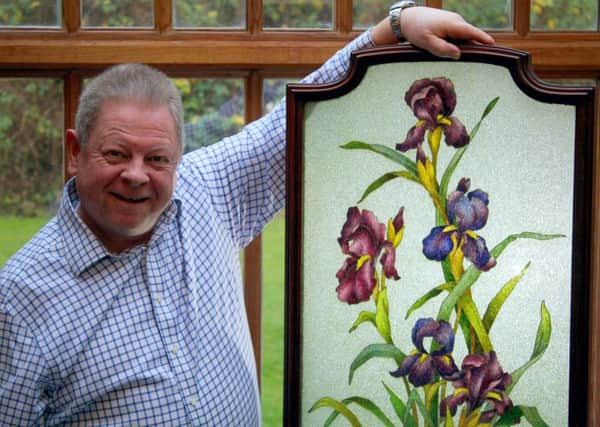HIDDEN HERITAGE: Reviving a long-lost glass craft


An alternative to stained glass, the ‘cold process’ differed from cloisonné enamel, a popular form of decoration on objects, jewellery and furniture at the time.
The technique, now little known of and rarely seen, has been researched by a local man who hopes re-popularise the artform in 2019.
Advertisement
Hide AdAdvertisement
Hide AdThe Cloisonné Glass Company, as they were at the turn of the 20th century, constructed its works by layering carefully crafted materials. Firstly, a clear glass was positioned over a design and a series of gold-plated wires were bent to follow the shapes of the drawing beneath and glued in position. Reminiscent of the lead between cut pieces in stained glass, the precision bending and positioning of the wires was the most crucial step as they had to lie perfectly flat.
Unlike stained glass, cloisonné glass allows for subtle gradations in colour and there is more flexibility in design as the wires don’t have to join in the same way as lead.
The voids between the wires were then filled with tiny glass ‘blind beads’ (no hole) or ‘frit’ (crushed glass), which was bonded with glue before a coversheet of glass was applied. The word ‘cloisonné’ comes from the French ‘cloison’, meaning compartment.
Cut to the mid-1990s when a customer brought in a piece of glass for repair at The Stained Glass Centre in West Jesmond.
Advertisement
Hide AdAdvertisement
Hide AdIan Wilton and his son Neil, with 30 years’ experience between them, had never seen the like, so Ian began researching the craft. Ian determined to learn all he could about the lost art form.
He wrote to the London Victorian Society, which put it in its newsletter. A lady whose father had been a carpenter in the adjoining workshop to the Cloisonné Glass Company saw the letter and got in touch. Her father had created the woodwork to hold the glass in windows, tables, trays, fireguards and intricate cabinets.
Ian discovered the original 1905 catalogue in the V&A museum and Neil began collecting pieces made by the Cloisonné Glass Company as he came across them. The pieces are relatively low value, and almost always damaged, but he has painstakingly reverse-engineered the craft and developed a system of lighting the pieces to show their full beauty.
An earlier 1901 catalogue, now in Neil’s possession, includes a wide range of designs which are ‘unmistakable’ to an expert. These designs would have been selected by customers who decided whether to commission them in a lampshade, fireguard or wall piece. Each item is bespoke, although popular motifs include peacocks, irises and elaborate swirls. The company advertised its pieces as ‘burglar-proof’ and ‘easily repaired’, neither of which was true.
Advertisement
Hide AdAdvertisement
Hide AdThe Cloisonné Glass Company closed in 1927 and, in lieu of paying some tradesmen’s bills, gave away finished and unfinished items from the workshop. The skill and attractiveness of each piece in the collection is obvious, even in the smallest – an ashtray featuring a bulldog.
Now Neil has perfected the formula of the glue, learned how to make glass beads from recycled bottles and stained-glass off-cuts, as the original company would have done, and found a way to bend the wires consistently. He plans to offer classes to experienced, dexterous crafters and even to design DIY craft kits which could be completed at home.
If you would like to try it, get in touch at [email protected]